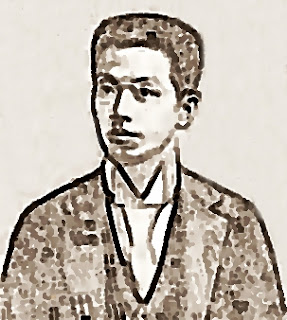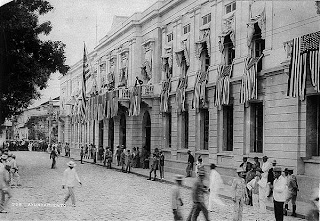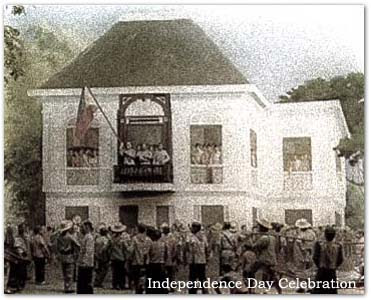Thursday, June 30, 2011
30 JUNE
1897 - More than one and a half months after bloodily sealing his usurpation of revolutionary leadership from Supremo Andres Bonifacio y de Castro, Gen. Emilio Aguinaldo has the nerve to call on everyone who possesses honor and the sense of personal dignity, the Filipino, the Asiatic, the American and the European all alike suffer; to join the Revolution against Spain; Aguinaldo earlier dislodged Bonifacio, leader of the underground-society-turned-revolutionary-government Kataas-taasang, Kagalang-galangang Katipunan ng mga Anak ng Bayan (KKK), from the helm of revolutionary leadership through the fraudulent and anomalous March 1897 Tejeros Convention , subsequently ordering the dead-or-alive abduction of Bonifacio, his kangaroo court martial and then the murder-by-execution of the Supremo and his brother Procopio on May 10, 1897; one of the other "winners" in the Tejeros Convention, Gen. Artemio Ricarte, issued a declaration stating in part that the Tejeros Convention "had not been in conformity with the true will of the people" as a Katipunan official earlier warned Bonifacio of ballots pre-filled with Magdalo names, apparently prompting Bonifacio to issue the Acta de Tejeros that nullified the results of the elections and later co-signing the Naik Military Agreement that declared several Filipino revolutionaries (referring to but not naming the side of Aguinaldo as having committed treason against the nation and the revolution by trying to forge a peace pact with the enemy Spanish colonial forces; Apolinario Mabini y Maranan, future key adviser of Aguinaldo, will a few years later write in his memoirs that Aguinaldo was behind the "crime" of the "assassination" of the Supremo.
Wednesday, June 29, 2011
29 JUNE
Tuesday, June 28, 2011
28 JUNE
Monday, June 27, 2011
27 JUNE
1864 - Father Apolonio Burgos y Garcia published during the Spanish colonial period a superb defense of Filipino priests in his Manifesto to the Noble Spanish People Which the Loyal Filipinos Address in Defense of their Honor and Loyalty;therein, the native priest deplores the racist assertions by white writers with inflated sense of their racial stock who allege that their pale-skinned race is superior over the colored races; Burgos also bewails the racial indignities the colonial Spanish authorities subject the natives of the Southeast Asian archipelago; the Filipino priest Burgos will later be executed, along with fellow clergymen Mariano Gómez and Jacinto Zamora who have been peacefully fighting for equal rights of native priests vis-a-vis Spanish friars, in the infamous execution of the GOMBURZA triumvirate in February 1872 based on false charges of subversion and practically without any defense in connection with the 1872 Cavite mutiny.
Sunday, June 26, 2011
26 JUNE
 |
| Colonial Spanish Gov. Manuel Pavia |
1854 - Manuel de Pavia y Lacy, Governor-General of the Philippine Islands during the Spanish colonial period, decrees the establishment of “Cartas de radio” (special radius permit), in the Central Luzon provinces of Laguna, Cavite, Bulacan, Pampanga and Tondo; the use of Cartas de radio, an identification paper aiming to safeguard the public from strangers, is to supposedly ensure peace and order by barring the entry of strangers into any province without proper identity paper(s); holding colonial office beginning from 1852, Pavia established monthly mail service between Manila and Hongkong and, as well, prisoners' funds amounting to four cuartos for a day of work as a way of helping prisoners deal with life outside following their release; Pavia will return to Madrid to unsuccessfully defend Queen Isabella II during the Spanish Revolution of 1868 and will die in Madrid in 1896; ; during Pavia's term as colonial governor of the Southeast Asian islands, he reequipped the colonizing army and suppressed a formidable 1854 mutiny by a number of Filipino native troops.
Photo credit: http://www.todocoleccion.net/excmo-sr-don-manuel-pavia-lacy-marques-novaliches-capitan-general-ejercito~x25487835
Saturday, June 25, 2011
25 JUNE
 |
| Rounsevelle Wildman U. S. Consul-General at Hong Kong |
1898 - American Consul General at Hong Kong Rounseville Wildman foxily writes Philippine President Emilio Aguinaldo y Famy convincing him to stand shoulder to shoulder with what will be the future invading American forces, saying that he has supposedly "vouched for [Aguinaldo's] honesty and earnestness of purpose to the President of the United States and to [the American] people," during the Revolution after the Filipinos have declared Independence following their liberation of majority of the archipelago from the hands of Spanish colonizers; the communications of Wildman, who will later rip off Aguinaldo of P67,000 intended for a second shipment of arms and ammunition, have been instrumental in making Aguinaldo stupidly trust imperialist Commodore George Dewey with whom he forged an alliance against Spain and his deceptive promises of honoring Philippine Independence; Aguinaldo will soon allow the American forces to freely enter Philippine territory and thereby position themselves for their sinister scheme of invading the fledgling Southeast Asian Republic, erupting into the bloody and protracted Filipino-American War (1899-1914).
Friday, June 24, 2011
24 JUNE
| Hen. Gregorio del Pilar y Sempio |
1898 - Gregorio del Pilar y Sempio liberates the town of Bulakan, Bulakan province from the Spanish forces during the second phase of the Philippine Revolution against Spain; Filipino revolutionaries some weeks ago earlier scored major victories in the province, capturing and taking the station in Bigaa, Bulacan, which was garrisoned by 24 men of the Spanish Infantry and Rural Guards and taking control of nine (9) other Bulacan towns; one of the youngest generals of the Filipino forces, Gregorio del Pilar will soon be promoted brigadier-general and will also be responsible for the successful repulsion of the imperialist American invaders in the Battle of Quingua (Plaridel) where American Col. John M. Stotsenberg will die in April 1899 during the early phase of the Philippine-American War (1899-1914).
Thursday, June 23, 2011
23 JUNE
 1898 - Gen. Emilio Aguinaldo y Famy changes the form of government from Dictatorial to Revolutionary following the recent Declaration of Philippine Independence when most but not yet all of the provinces and cities have been liberated by the Filipino patriots during the second phase of the Revolution against Spain; President Aguinaldo, who has acted upon the advice of Apolinario Mabini y Maranan, his chief adviser, also issues a decree establishing a Revolutionary Committee abroad; unknown to Aguinaldo, who earlier forged an alliance with American Admiral George Dewey to fight Spain and subsequently apparently duped into stupidly thinking that the rising imperialist nation the United States of America is an ally, the two colonial countries are to later sign a peace protocol to halt Spanish-American War hostilities, thus 'authorizing' the Bald Eagle nation to occupy and hold the city, bay, and harbor of Manila pending the conclusion of a treaty set to define the control, disposition, and government of the Philippines; Spain and the U.S will stage the infamous Mock Battle of Manila to falsely show to the world that it is the Bald Eagle soldiers instead of the Filipinos who have defeated the Spaniards, sign the Treaty of Paris that will ridiculously and baselessly 'cede' the Philippines to the imperialist U.S. and by February 1899, the Philippine-American War (1899-1914) will commence.
1898 - Gen. Emilio Aguinaldo y Famy changes the form of government from Dictatorial to Revolutionary following the recent Declaration of Philippine Independence when most but not yet all of the provinces and cities have been liberated by the Filipino patriots during the second phase of the Revolution against Spain; President Aguinaldo, who has acted upon the advice of Apolinario Mabini y Maranan, his chief adviser, also issues a decree establishing a Revolutionary Committee abroad; unknown to Aguinaldo, who earlier forged an alliance with American Admiral George Dewey to fight Spain and subsequently apparently duped into stupidly thinking that the rising imperialist nation the United States of America is an ally, the two colonial countries are to later sign a peace protocol to halt Spanish-American War hostilities, thus 'authorizing' the Bald Eagle nation to occupy and hold the city, bay, and harbor of Manila pending the conclusion of a treaty set to define the control, disposition, and government of the Philippines; Spain and the U.S will stage the infamous Mock Battle of Manila to falsely show to the world that it is the Bald Eagle soldiers instead of the Filipinos who have defeated the Spaniards, sign the Treaty of Paris that will ridiculously and baselessly 'cede' the Philippines to the imperialist U.S. and by February 1899, the Philippine-American War (1899-1914) will commence.
Wednesday, June 22, 2011
22 JUNE
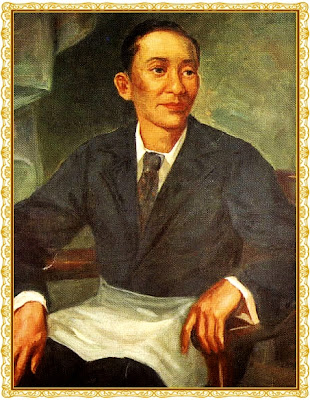
1900 - Sixteen months into the bloody and protracted Filipino-American War (1899-1914) but after the invading imperialist United States forces have arrested some key people of the fledgling Philippine Republic, Gen. Arthur McArthur, the assigned American 'military ruler,' offers former Philippine Prime Minister Apolinario Mabini y Maranan amnesty in exchange for swearing fealty to the Bald Eagle flag; Mabini, considered as the "Brains of the [second phase of] the Revolution," was jailed for being "a most active agitator" [translation: patriot] and persistently and defiantly refusing amnesty, and maintaining correspondence with insurgents [translation: defenders of the Philippine Republic]; even when Mabini will finally take his oath of allegiance to the US in 1903 after two years of being exiled to Guam in his yearning to return to his homeland shortly before his death from illness, Mabini will supposedly resume his patriotic work of agitating for independence; it is in exile that Mabini will write "The Philippine Revolution" based on his memoirs of the Himagsikan against Spain, including the part of the "crime" of the "assassination" of the Supreme President of the underground-society-turned-revolutionary-government Kataastaasang Kagalanggalangang Katipunan nang manga Anak nang Bayan Andres Bonifacio y de Castro on orders of Gen. Emilio Aguinaldo y Famy under whose presidency Mabini served as key adviser and Prime Minister.
Raw photo credit: http://mrrml355.blogspot.com/2011/02/sublime-paralytic.html
Tuesday, June 21, 2011
21 JUNE
 | |||||
| Pedro Paterno - autonomist/traitor |
Monday, June 20, 2011
20 JUNE
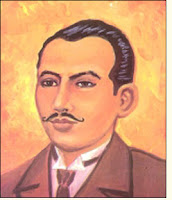 |
| Mariano Ponce |
1899 - 10,000 Murata rifles, 6,000,000 rounds of ammunition, and other war supplies purchased by Mariano Ponce from the Japanese start sailing aboard the Nonubiki Maru from Nagasaki to the Philippines four months into the Filipino-American War (1899-1914); earlier in September 1898, Ponce and F. Lichaucho had sought approval for arms purchase in a letter to Apolinario Mabini y Maranan, Foreign Affairs Minister and chief adviser of President Emilio Aguinaldo y Famy, stating that Japanese officials are inclined to favor the Philippine cause against the North American imperialist aggression although they only wish to avoid "the possibility of a conflict with... the Yankee one"; unfortunately, the privately-charted Japanese steamer will sink during a typhoon in the South China Sea before reaching the Philippines, the Bald Eagle nation through Admiral George Dewey had some 13 months earlier forged an alliance with Aguinaldo to fight Spain, deceptively promising the then-revolutionary leader that the United States would honor Filipino independence, only to instigate the Phil-Am War and manipulate news about it in the bid of US President William McKinley to make the Senate vote for the annexation [read: invasion] of the Southeast Asian archipelago and to approve the Treaty of Paris; the New York Times will erroneously report that the report about the arms shipment is false based on a supposed story in a Tokyo newspaper, saying that while Japanese:
"...admire the pluck of the Filipino people, who belong to the same race and with whom the Japanese have had some close relations in the past [they] are not badly disposed toward the Americans."
Photo credit: http://ngayonsakasaysayan.blogspot.com/
Sunday, June 19, 2011
19 JUNE
 |
| Gat Jose Rizal |
Saturday, June 18, 2011
18 JUNE
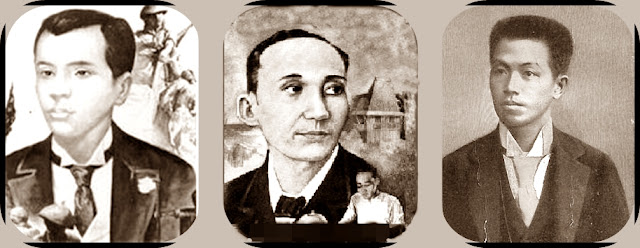 |
| Andres Bonifacio - Apolinario Mabini - Emilio Aguinaldo |
1898 - Philippine President Emilio Aguinaldo y Famy issues a degree reorganizing the provinces and municipalities through the election of Popular Assemblies, whose heads the town chiefs then [elect] the provincial councils; Apolinario Mabini y Maranan, Aguinaldo's chief adviser, sees the reorganization as the "direct link to the masses" of Aguinaldo, who over a year earlier ascended to the leadership of the Philippine Revolution against Spain by ousting and then ordering the assassination-cum-execution of Andres Bonifacio y de Castro, Supreme President of the mass-based secret-society-turned-revolutionary-government of Kataastaasang Kagalanggalangang Katipunan nang manga Anak nang Bayan Supremo Andres Bonifacio; the decree came six days after Aguinaldo proclaimed the country's Independence from the yoke of some three hundreds years of Spanish colonial rule following the second phase of the Philippine Revolution marked by the return from exile of Aguinaldo and a number of revolutionary generals who broke the peace pact they earlier forged with the enemy colonial Spaniards; Aguinaldo had some two months earlier forged an 'alliance' with the emerging imperialist nation, the United States of America, to fight Spain after being conned into believing the deceptive promises made by Admiral George Dewey, et al. that the Bald Eagle nation will supposedly honor the independence of the Filipinos.
Friday, June 17, 2011
17 JUNE
 |
| Gen. Manuel Tinio y Bundoc |
“I have endeavored to propagate and implant here the society of the Katipunan which has produced surprising results. I have prepared the spirit of the inhabitants so that aside from inculcating in them the fecund germ of the high ideals of liberty, they have come to show implacable hatred towards the invader, passion which some citizens, armed with only bolos have manifested to the Americans who dared to travel from their detachment.”
Raw image credit: http://en.wikipedia.org/wiki/File:Gen._Manuel_Tinio.jpg
Wednesday, June 15, 2011
16 JUNE
 |
| Imperialist Consul Oscar F. Williams |
1898 - During the Philippine Revolution against Spain, American Consul Oscar F. Williams sends a dispatch to Secretary Wm. R. Day reporting that the Filipino revolutionaries have defeated the colonial forces at practically all encounters and have taken control of the northern provinces and the entire bay coast, save for the city of Manila; the Bald Eagle nation represented by Admiral Spencer Dewey had earlier forged an alliance with Aguinaldo in line with the briefly fought Spanish-American War; the success of the Filipinos in breaking the yoke of Spanish colonization, however, will later be stolen by the Americans who will stage the Mock Battle of Manila to make it appear that it is they who defeated the Spaniards after duping Pres. Emilio F. Aguinaldo into freely allowing the entry of the forces of the emerging imperialist United States into the Philippine archipelago supposedly as friendly troops.
Photo credit: http://mcnygenealogy.com/bios/williams-oscar.jpg
15 JUNE
 |
| Gen. Vito L. Belarmino |
1857 - Vito Belarmino y Loyola, one of the most brilliant Filipino military leaders during the Philippine Revolution against Spain and during the Filipino-American War (1899-1914), is born in Silang, Cavite; Belarmino would join the Kataastaasang Kagalanggalangang Katipunan nang manga Anak nang Bayan and engage the Spaniards in various skirmishes, including the 1896 attack he and Vicente Giron will launch against colonial Spanish guards and a convent in Silang; later, during the Fil-Am War, would be given command of Albay province to establish a [local[ republican government; he and Gen. Jose Paua will put up a valiant fight to defend Legaspi , Albay against the Bald Eagle forces led by Gen. William Kobe; following the fall of Tabaco and Naga tragically in February 1900 to the invading imperialist United States forces, Paua will soon surrender but Gen. Belarmino will for a time persist in his patriotic duty and will defiantly organize a guerrilla outfit [to] repeatedly [harass] American installations in the Bicol region.
Tuesday, June 14, 2011
14 JUNE
 |
| U.S.-sponsored Philippine President Manuel L. Quezon |
Photo credit: http://bentley.umich.edu/research/guides/philippines/philipp_search.php?id=79
Monday, June 13, 2011
13 JUNE
 |
| Battle of Zapote Bridge (River) American invaders captured Filipino cannons, 13 June 1899 |
Raw photo credit: http://philippineamericanwar.webs.com/southofmanilacampaign.htm
Sunday, June 12, 2011
12 JUNE
1898 - Gen. Emilio Aguinaldo y Famy, leader of the second phase of the Philippine Revolution against Spain, proclaims the Independence of the Philippines "under the protection of the Powerful and Humanitarian Nation," that is the United States of America and thereby ceasing "to have any allegiance to the Crown of Spain" and unfurling a blue, red and yellow flag partly inspired by the Stars-and Stripes banner of the imperialist United States; ironically, within eight months, the Bald Eagle nation will show the pathetically deceived Aguinaldo its true color as it invades the fledgling Southeast Asian republic by instigating the hostilities with the Filipino troops under a vile pre-arranged plan on February 4, 1899, of which the resulting savage Filipino-American War (1899-1914) will last for a bloody ten years or so.
Photo credit: http://www.beda7882.com/Photos/Phil_History/Philippine-Independence-Declaration-1898.jpg
Saturday, June 11, 2011
11 JUNE
 |
| President Carlos P. Garcia |
1971 - Former Philippine President Carlos Garcia y Polistico is elected president of the 1971 Constitutional Convention assembled to revise the 1935 Philippine Charter during the second term of President Ferdinand Marcos y Edralin; Garcia, who served as the head of state of the Philippine Republic from 1957-1961, will die from heart attack within only three days from election as Con-Con head, permitting the constitutional body's vice-president, former Philippine President Diosdado Macapagal y Pangan, to take charge of the writing of the country's new charter; a lawyer, former law professor, congressman and three-time governor of Bohol, Garcia was elected Senator for three terms before running successfully for Vice-President and then for President in 1957; Garcia will be remembered for his administration's near iconic legacy of "Filipino First" policy which put the interests of the Filipino people above those of foreigners and of the ruling party.
Photo credit: http://en.wikipedia.org/wiki/File:Carlos_P_Garcia.jpg
Friday, June 10, 2011
10 JUNE
 |
| Gen. Emilio F. Aguinaldo - Admiral George Dewey |
"It was with the assistance of Aguinaldo as a guide that Dewey entered the bay, and subsequent events proved that Aguinaldo has kept all his promises but the interesting feature of this incident is that no official announcements or publications of the facts have emanated from the Government at Washington."
Photo credits:
http://alumni.imsa.edu/~bruce/projects/images/occupation/aguinal.jpghttp://opmanong.ssc.hawaii.edu/filipino/graphics/dewey.gif
Thursday, June 9, 2011
9 JUNE
1945 - Manuel Roxas y Acuna is elected President of the Senate during a special session of Congress called by President Sergio Osmena y Suico following the defeat of the Japanese and the end of World War II but with the Philippines still a colony of the United States; this early, Roxas already has set his on the sights on the presidency, with American Gen. Douglas MacArthur and High Commissioner Paul V. McNutt supporting him, and in the elections of 1946, will win amidst Osmena's refusal to campaign; following the granting of Philippine "independence" in 1946, Roxas would be responsible for the neocolonial arrangement of the Philippines and the imperialist Bald Eagle nation, with the lopsided and inimical-to-Filipino-interests RP-US Military Bases Agreement (MBA) and so-called Parity Rights to be successfully pushed by his administration; the MBA will grant American access to 22 military, naval, and air bases in the Southeast Asian nation, with Roxas lobbying for its passage in the Philippine Congress despite the MBA despite being a mere international executive agreement on the American side, not having been ratified by the U.S. legislature; on the other hand, the Parity Rights amendment to the 1935 Constitution will ridiculously give American citizens the same equal rights as Filipinos to exploit the natural resources of the country.
Photo credit: http://www.philippine-history.org/images/Manuel-A-Roxas.jpg
Photo credit: http://www.philippine-history.org/images/Manuel-A-Roxas.jpg
Wednesday, June 8, 2011
8 JUNE
| Gen. Pio del Pilar |
Photo credit:
http://www.freewebs.com/philippineamericanwar/combatinmanilasuburbs.htm
Tuesday, June 7, 2011
7 JUNE
 |
| Gen. Artemio Ricarte y Garcia, a.k.a "Vibora" |
Raw photo credit: http://webzoom.freewebs.com/philippineamericanwar/Artemio%20Ricarte%20with%20%20sombrero.jpg
Monday, June 6, 2011
6 JUNE
 |
| Col. Francisco "Paco" Roman - Gen. Antonio Luna - Gen. Emilio Aguinaldo (Photo art: JB) |
1899 - One day after his bodyguards murdered Gen. Antonio Luna y Novicio (and aide-de-camp Col. Francisco Roman), the perceived threat to his position as revolutionary leader, Dictator President Emilio Aguinaldo wires all the military chiefs in five northern provinces to the effect that he is taking active direction of the military operations and that he is establishing his temporary headquarters at Bamban, Tarlak four months into the bloody and protracted Filipino-American War (1899-1914); Aguinaldo would be widely blamed for setting a trap for the assassination because he did not meet Luna despite his signed telegram calling the former to a conference and because it will be reported that his mother, looking out the window of the convent in Cabanatuan and witnessing at least part of the assassination, uttered: "Is he still breathing?"; it would later be reported that Gen. Venancio Concepcion, then in Angeles, received a telegram from Aguinaldo at about the time of the Luna assassination informing the former that he (Aguinaldo) had taken over the control of military operations in the Central Luzon area and that, further, he was on his way to Bamban which he will be using as his new temporary executive and military headquarters; Aguinaldo would also carry out loyalty checks and arrest of military subordinates loyal to Luna, with some being reportedly killed , including Major Manuel Bernal who would be tortured first before being liquidated.
1898 - Gen. Emilio Aguinaldo y Famy, issues a decree delineating the geographic and political divisions of provinces and appointing a military chief for each zone during the so-called second phase of the Philippine Revolution against Spain; one year and three weeks earlier, Aguinaldo tightly sealed his power grab against Generalissimo Andres Bonifacio y de Castro, the Supreme President of the secret-society-turned-revolutionary-government Kataastaasang Kagalanggalangang Katipunan nang manga Anak nang Bayan when he ordered the 'dead or alive' seizure and kangaroo court martial and eventual execution-cum-assassination of the Bonifacio brothers; Aguinaldo has claimed leadership of the revolution on the basis of the controversial and fraudulent March 1897 Tejeros Convention, reportedly marked by the use of pre-filled ballots and by scandalous irregularities that actually prompted its nullification by Bonifacio (who served as presiding officer) through the Acta de Tejeros; the more progressive historians would condemn the Tejeros Convention as a coup and a counterrevolution, as Apolinario Mabini, who would serve as Aguinaldo's Prime Minister, would later decry the power grab from, and "assassination," of Bonifacio as constituting Aguinaldo's insubordination against the leader of the Katipunan and as the "first victory of personal ambition over true patriotism."
Sunday, June 5, 2011
5 JUNE
 |
| Hen. Antonio Luna y Novicio |
Photo credit: http://en.wikipedia.org/wiki/Antonio_Luna
Saturday, June 4, 2011
4 JUNE
 |
| Hen. Gregorio del Pilar y Sempio - Hen. Isidoro Torres y Dayao |
Photo art: JB
Original photo credits: http://philippineamericanwar.webs.com/
Friday, June 3, 2011
3 JUNE
 |
| Spanish troops will be forced back by Filipino revolutionaries in the Battle of Zapote Bridge |
1898 - Filipino troops take control of areas of Manila--Caloocan, Tondo, Santa Cruz, San Juan del Monte, Santolan as their counterparts in Zapote, Cavite province numbering only about 500 drive back the 3,500-strong enemy Spanish forces, while Spaniards in Calamba, Laguna surrender to Gen. Paciano Rizal following three days of fighting during the second phase of the Philippine Revolution against Spain; Gen. Emilio F. Aguinaldo, who had earlier forged a truce with the enemy Spaniards within a few months after seizing revolutionary leadership from, and eliminating, Katipunan Supremo Andres Bonifacio y de Castro, returned two weeks earlier to resume the Himagsikan apparently after being convinced by imperialist United States Admiral George Dewey; Aguinaldo has formed an alliance with Dewey who has deceptively assured him believe that the Bald Eagle nation is a friend and ally of the Philippines and will honor its independence from Spain.
Photo credit: http://philippineamericanwar.webs.com/emilioaguinaldoreturns.htm
Thursday, June 2, 2011
2 JUNE
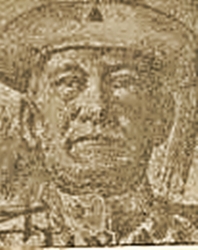 |
| Sen. Juan Sumulong y Marquez |
1931 - Juan Sumulong y Marquez, dubbed the "Brains of the Opposition" during the ascendancy of the first President of the Philippine Senate and the Commonwealth [dependent territory] during the American Colonial period, Manuel L. Quezon, resigns from the Democrata party due to poor health; a revolutionary during the Philippine Revolution against Spain, Sumulong became a member of the Philippine Commission [read: imperialist American-sponsored legislative body] from 1909-1913, later becoming a senator after several previous unsuccessful candidacies; one of the political figures opposed to the Hare-Hawes Cutting Act that grants the United States continued sovereignty over U.S. Military Reservations in the country, Sumulong would later bitterly denounce what will be the coalition of Quezon's Partido Nacionalista and the opposition party of Sergio S. Osmena, believing that political representation should be balanced to prevent oligarchy.
Photo credit: Wikipedia
Wednesday, June 1, 2011
1 JUNE
1898 - The capitulation of Spanish colonial forces led by Major Juan Enriquez to Filipino revolutionary leader, Captain Simeon Dionisio of Bataan province during the Philippine Revolution is formalized in Pilar town in the "Acta de capitulacion, Pilar, Bataan, 1 de Junio 1898"; the Act is certified by the Secretary Albino Reyes, with signatories including Capt. Dionisio on the Filipino side and on the Spanish side, Maj. Enriquez who has supposedly witnessed the futility of further resisting the wave of Philippine revolution and has found it wiser to avert needless greater bloodshed.
Raw photo credit: http://t1.gstatic.com/images?q=tbn:ANd9GcRpBKTN7pj_u0_BGv7-AE8UTw1QYRFdO0TI2Jz7_n1UNeoIPTqf&t=1
Subscribe to:
Posts (Atom)
